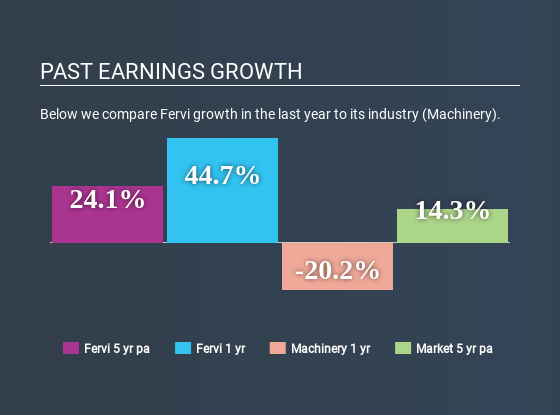Fervi S.p.A.'s (BIT:FVI) Fundamentals Look Pretty Strong: Could The Market Be Wrong About The Stock?

Fervi (BIT:FVI) has had a rough three months with its share price down 5.6%. However, a closer look at its sound financials might cause you to think again. Given that fundamentals usually drive long-term market outcomes, the company is worth looking at. Particularly, we will be paying attention to Fervi's ROE today.
Return on equity or ROE is a key measure used to assess how efficiently a company's management is utilizing the company's capital. In short, ROE shows the profit each dollar generates with respect to its shareholder investments.
View our latest analysis for Fervi
How Is ROE Calculated?
The formula for return on equity is:
Return on Equity = Net Profit (from continuing operations) ÷ Shareholders' Equity
So, based on the above formula, the ROE for Fervi is:
12% = €2.6m ÷ €22m (Based on the trailing twelve months to December 2019).
The 'return' is the income the business earned over the last year. That means that for every €1 worth of shareholders' equity, the company generated €0.12 in profit.
What Has ROE Got To Do With Earnings Growth?
Thus far, we have learnt that ROE measures how efficiently a company is generating its profits. We now need to evaluate how much profit the company reinvests or "retains" for future growth which then gives us an idea about the growth potential of the company. Assuming everything else remains unchanged, the higher the ROE and profit retention, the higher the growth rate of a company compared to companies that don't necessarily bear these characteristics.
Fervi's Earnings Growth And 12% ROE
To begin with, Fervi seems to have a respectable ROE. Further, the company's ROE compares quite favorably to the industry average of 6.5%. This certainly adds some context to Fervi's exceptional 24% net income growth seen over the past five years. However, there could also be other causes behind this growth. For instance, the company has a low payout ratio or is being managed efficiently.
As a next step, we compared Fervi's net income growth with the industry, and pleasingly, we found that the growth seen by the company is higher than the average industry growth of 2.0%.
Earnings growth is an important metric to consider when valuing a stock. It’s important for an investor to know whether the market has priced in the company's expected earnings growth (or decline). By doing so, they will have an idea if the stock is headed into clear blue waters or if swampy waters await. Has the market priced in the future outlook for FVI? You can find out in our latest intrinsic value infographic research report
Is Fervi Using Its Retained Earnings Effectively?
Fervi's three-year median payout ratio to shareholders is 21%, which is quite low. This implies that the company is retaining 79% of its profits. So it looks like Fervi is reinvesting profits heavily to grow its business, which shows in its earnings growth.
While Fervi has been growing its earnings, it only recently started to pay dividends which likely means that the company decided to impress new and existing shareholders with a dividend.
Conclusion
On the whole, we feel that Fervi's performance has been quite good. Particularly, we like that the company is reinvesting heavily into its business, and at a high rate of return. Unsurprisingly, this has led to an impressive earnings growth. If the company continues to grow its earnings the way it has, that could have a positive impact on its share price given how earnings per share influence long-term share prices. Not to forget, share price outcomes are also dependent on the potential risks a company may face. So it is important for investors to be aware of the risks involved in the business. Our risks dashboard would have the 2 risks we have identified for Fervi.
Love or hate this article? Concerned about the content? Get in touch with us directly. Alternatively, email editorial-team@simplywallst.com.
This article by Simply Wall St is general in nature. It does not constitute a recommendation to buy or sell any stock, and does not take account of your objectives, or your financial situation. We aim to bring you long-term focused analysis driven by fundamental data. Note that our analysis may not factor in the latest price-sensitive company announcements or qualitative material. Simply Wall St has no position in any stocks mentioned. Thank you for reading.

